The canals in Venice are not dug. They are streams, rivers, and parts of the lagoon. During the centuries they slowly became surrounded by the foundation of the city and the stone embankments slowly turned the rivers into canals. Both Canale della Giudecca and Canal Grande were branches of the river Medoacus Maior, another name for Brenta, the river that flows through Padova.
Canale Grande is, and always was, the main transport route in Venice. It is 3.8 km (2.4 mi) long, and 30 to 90 m (98 to 295 ft) wide, with an average depth of 5 meters (16 feet). It floats in a reverse S-shape from northwest to southeast, and it’s lined with the most prestigious buildings in Venice. In the past, all the most important Venetian families had their residents on the Grand Canal of Venice and that has created a unique collection of mostly renaissance palaces facing the canal.
Riviera di Brenta
From Canal Grande, you can go by boat west to Fusina, and up the river Brenta. There, the nobles of Venice had their mainland residences. A sanctuary especially in times of disease (Bubonic Plague). Today, the Riviera di Brenta holds an almost equally astonishing line of palaces as the Grand Canal of Venice.
Now, all that being said, let’s start our journey. Get on the Vaporetto at Piazzale Roma. Nr 1 or nr 2. Number 1 makes all the stops, while number 2 makes just a few. It’s a choice of how fast you want to go.
If you manage to be first in line, hurry on to the outdoor seats up front, to the side of the driver. Just remember to sit down, or you’ll obstruct his view.
Here we go…
Ponte della Costituzione (Ponte Calatrava) – Constitution Bridge.

After take-off, just look straight up. We’re going under the Calatrava Bridge. It was made by the famous Spanish artist Santiago Calatrava in 2007. It has never been particularly appreciated by the Venetians (… But they’re never easily convinced, especially when it comes to bridges over the most important canal of Venice.)
One problem is that the beautiful curve has made the steps irregular. They start out with a normal height, but as you get closer to the top, the steps become lower and longer. The glass floor can also become slippery. Many tourists and locals alike have been injured from simply falling while walking.
On the left side of the bridge (looking from the left side of the Vaporetto) there used to be a cocoon attached to the bridge. When the construction was completed, they realized that they forgot to put wheelchair ramps, mandatory by law. And as Santiago Calatrava refused to compromise his art piece with any added rails or constructions, an egg had to be added on the side. It has now been removed.
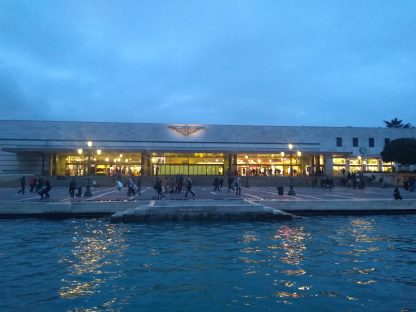
Stazione Santa Lucia – The Train station.
The railway bridge from the mainland to Venice was built in 1846, and 15 years later the first real railway station was built. In the 1930s, during the fascist era, a new station was built to replace the older and smaller building from 1860. Responsible for the layout was the Italian state-architect Angiolo Mazzoni. The facade shows the typical neo-classist/rationalistic, a bit bombastic style of the time. It was completed after the war.
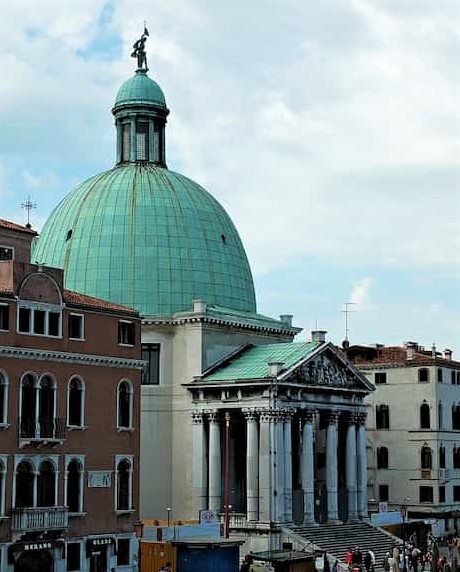
Chiesa di San Simeon Piccolo
Opposite the railway station. It was built at the beginning of 1700 by Giovanni Antonio Scalfarotto, The facade is modeled on the Pantheon in Rome.
Underneath the church, there is a crypt, that you can visit, with a candle. There are 21 small chapels down there, but eight of them are still walled up and unexplored. Supposedly they have been opened but immediately closed again. Some things in this world are not meant to be awakened…
Ponte dei Scalzi (or the railway-station bridge)

The second bridge over Canal Grande. The bridge was completed in 1934, replacing an older iron bridge. On the railway-station-side, there’s a church, Santa Maria di Nazareth. That was the holy temple of the Order of the Discalced Carmelites of the Blessed Virgin Mary of Mount Carmel… Barefoot monks. The name Scalzo means barefoot.
San Geremia
On your left before the entrance to Canale di Cannaregio. This is an important pilgrimage church as it now holds the relics of Saint Lucia from Siracuse. The first version of the church is from the 11th century. Not only Saint Lucy lies here but also Saint Magnus, one of the first inhabitants of Rialto/Venice. Already in the 7th century, he started out constructing churches on the sandbanks.
According to legends, Saint Magnus contributed to the construction of 8 Venetian churches, among which San Salvador, Santa Maria Formosa, and Angelo Raffaele. This should have happened when Venice was still no more than a few muddy banks. If it’s true or not, those early buildings couldn’t have had anything to do with the churches with identical names, you see today.

San Marcuola
On your left at the Vaporetto-stop. The original church was from the 13th century. When they made a complete and thorough overhaul in the 1730s, they forgot to set aside resources for the facade. It was never completed.
Fontego dei Turchi – Natural History Museum
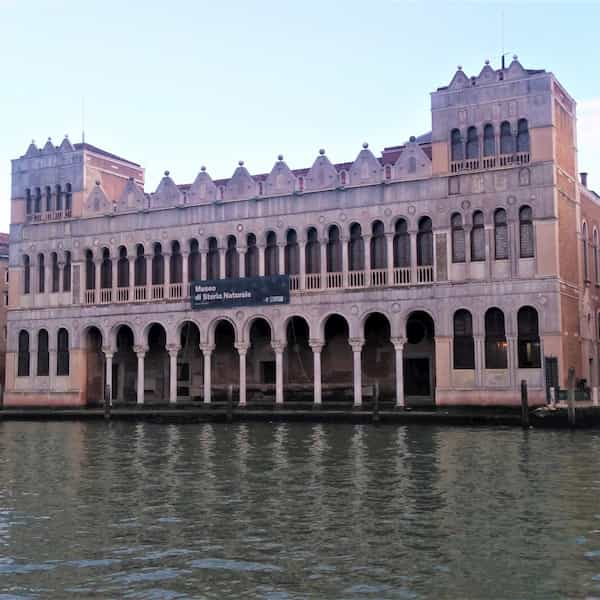
Opposite San Marcuola you’ll see a big Gondola behind the columns of a majestic palace. That’s Fondaco dei Turchi. It was a noble palace until 1621 when it was converted into a sort of Turkish Ghetto. Just like with the Jewish Ghetto, the first in the world, and the German Ghetto (which we will pass further ahead…), the republic wanted a certain control over the foreign market and the foreigners. They didn’t really trust their strange ways, but on the other hand, they didn’t want to create any obstacles to commerce… The pulsating heart of the Venetian republic.
So they made the palace into a big Turkish warehouse, store, workshop, and residential area. They wanted all the Ottomans in one spot, but a spot that was practical and could even improve their productivity. They were limited in some ways but promoted in others.
Nowadays it houses the Natural History Museum of Venice, which I can recommend.
Casinò – Cà Vendramin Calergi – The Casino

The palace was built around the turn of the 15th and 16th centuries as a home for a branch of the Loredan-family. The Loredans were very influential in the politics of the republic. Three Doges came from them as well as many Capitano Generale da Mar, General Capitan of the sea, or Commander of the sea. In Arab, that translates into amir-al bahr – admiral. (Sorry about the sidetrack…)
Today it’s the Casino of Venice. If you want to try your luck, you just walk in and play. There’s an entrance fee, but paying it includes free boat transport from Piazzale Roma. There’s a reasonably casual dress code until 8:30 pm. After that, gentlemen would need at least a jacket. Ladies should dress accordingly (… If that makes any sense.).
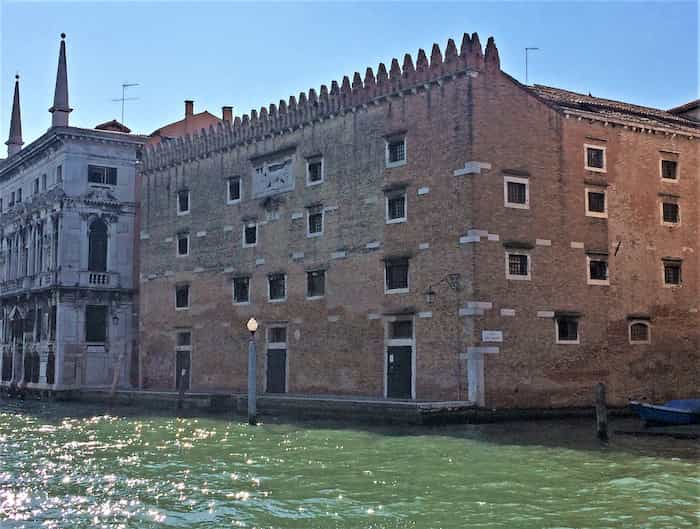
Fontego del Megio – City storage
Next to the Natural History Museum. The Fontego del Megio was built in the 13th century as a Grain depot (Megio, in Italian – Miglio – Millet.). An interesting building as it’s the only one on the Grand Canal of Venice that’s not a luxury residence. And it shows.

Chiesa di San Stae – San Stae church
A short distance further ahead on your right, at the Vaporetto stop. This one is from the beginning of the 1000s. The beautiful facade is by Domenico Rossi. It has many fabulous artworks inside.

Cà Pesaro
Two palaces further ahead on the right hand side. It was constructed in late 1600 by the architect Baldassarre Longhena (…who among other buildings made the drawings for Santa Maria della Salute), for the Pesaro family. It is home to the International Gallery of Modern Art.

Palazzo Donà
Next to Cà Pesaro. There were rumors about Johnny Depp having bought the Palazzo Donà. After filming The Tourist in Venice in 2010, the actor was supposed to have fallen in love with Venice to such a degree, that he decided to buy a house there. And this was supposed to be the house. It was not correct though. Johnny himself denied it many times. Checking with the real estate register, and the agency that was selling it at the time, it was easy to debunk. So, no, Johnny Depp does not own a house in Venice.
Cà D’Oro (The golden Palace)

On the left-hand side just before the Vaporetto-stop. This palace is the best example of Venetian Gothic architecture on the Grand Canal of Venice, and maybe in all of the city. It was built in the beginning of 1400 for the very rich and powerful Contarini Family. The name comes from the facade, which at the time was completely covered with gold leaf… The Golden Palace – Cà D’Oro.
Now the gold is all gone.
After the fall of the republic to Napoleon in 1797, the palace suffered from negligence and reckless renovations. Among other things, a staircase and balconies in the inner courtyard were removed. In 1894, Baron Giorgio Franchetti bought it, and from then on it has been taken well care of. Franchetti made a thorough restoration and reconstructed many of the lacking Gothic features.
The noble floor (The floor above the bottom floor) has columns and arches identical to those of Palazzo Ducale at Saint Mark’s. A sign of the kind of power the Contarinis possessed.
Today Cà D’Oro holds a collection of works of art collected by Giorgio Franchetti.

Loggia della pescheria – The fish market
On the right-hand side a bit further ahead. You will know by the smell if you come in the morning. This is where the Venetians buy their sea food. But take care… I’ve known a man, I won’t tell you his name, but he was commonly known as The Surgeon. Because nobody in the world was as knowledgeable as him when it comes to rearranging, cutting, and altering, to make an expired and stale fish become fresh again.
Don’t worry, he doesn’t work there anymore. Just come early and you’ll find the best and freshest fish from the Adriatic sea.
Fondaco dei Tedeschi
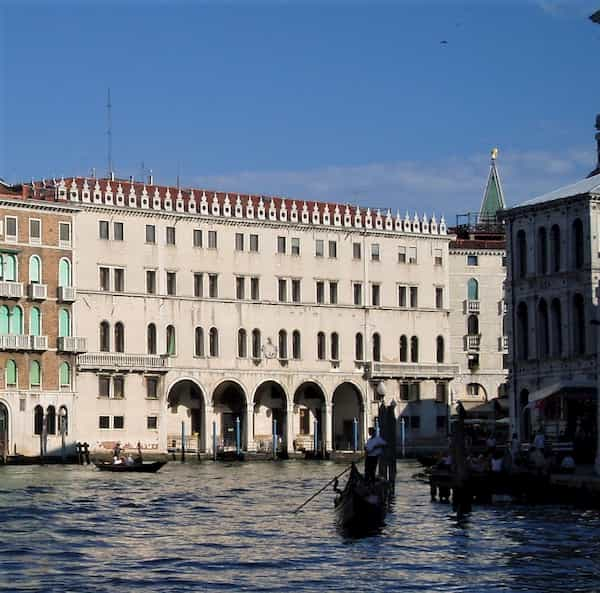
On your left right before the Rialto Bridge, there’s a big, white building with five arches at the bottom floor and three floors above instead of the normal two. The two top floors are also much lower and simpler than the usual Venetian Palace. Just like the case with the Turks and the Jews, this is where the Venetian republic put the Germans.
The palace is from 1508 but before that, there was another German guild here. Traders from across the Alps were present in Venice already from the birth of the republic, and when they built the first palace for the Germans, in the 13th century, it immediately became an important center for trade and business. Much of Venice’s wealth derived from bringing goods from the Orient and selling them in central Europe. And for that, they needed good and friendly relations with the Germans.
Now it’s a shopping center with a marvelous roof-top terrace for the perfect bird’s eye view picture. It is free of charge but it’s advisable to book ahead.
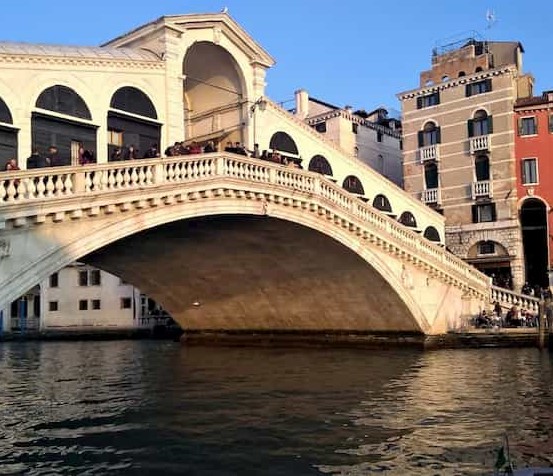
Rialto
The most famous bridge in Venice.
This is halfway through the Grand Canal of Venice. If you’re on nr. 2 it is possible that this is the end of the line. Some nr.2-Vaporettos do not continue after Rialto. You’ll have to ask. If they kick you off the boat here, just wait 10 minutes and the next one will take you further along the canal.
Even if it continues, this is where a lot of people get off, and new ones get on. It’s the perfect occasion to change seat if you weren’t able to get a good spot from Pz.le Roma. This works on nr. 1 as well.

Riva del vin
On your right when you’ve passed under the bridge, there is a long row of restaurants. Some of these are tourist traps, and I wouldn’t bring my friends here to have dinner. But it’s a nice place to have a snack and a Spritz overlooking the Grand Canal of Venice at one of its busiest parts.
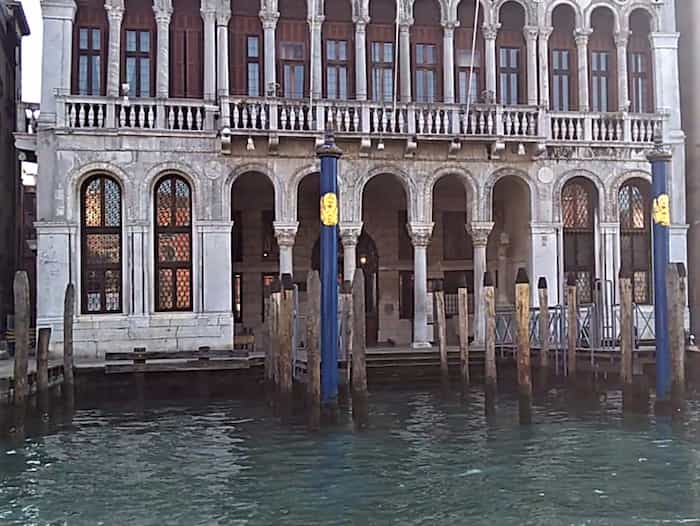
Cà Farsetti
After the two Vaporetto-stops on your left-hand side and opposite San Silvestro. Cà Farsetti was built by Doge Enrico Dandolo. He was the Doge who participated in the disastrous 4th Crusade. In the 15th century, it came in possession of one of the Contarinis, and in 1670 it was sold to the Farsetti family. In the 1700s it became a sort of cultural- and intellectual center for Venetians and tourists alike, with a vast collection of art and a library of immense dimensions.
From 1826 until today, it is the Municipality of the City of Venice.

Palazzo Papadopoli, Aman resort
On your right a hundred meters from Cà Farsetti. Palazzo Papadopoli, Aman Venice is a superior luxury hotel residing in the 16th century Palazzo. It is by many regarded as the best hotel in Venice. It could be so… I bet my money on Gritti Palace a few stops further ahead though.
Commissario Brunetti, Roof terrace

Another 100 meters ahead from Palazzo Papadopoli there’s a canal on your right. Inside that canal, on the right-hand side, the first palace after the one on the corner, there is a rooftop terrace. That’s the house of Commissario Guido Brunetti.
The American writer Donna Leon lived for 30 years in Venice. Her most famous books are all about the respected, and always well-dressed, Commissario of the Venice’ Police. 29 books have come out so far. and there’s no end in sight. The books about Guido Brunetti, and his murder-cases, are not translated into Italian, at Mrs. Leon’s request. So, none of my friends here knows about him.
But if you do, his rooftop terrace is right there, on top of the first house on the right after the corner-house.
Gondola service
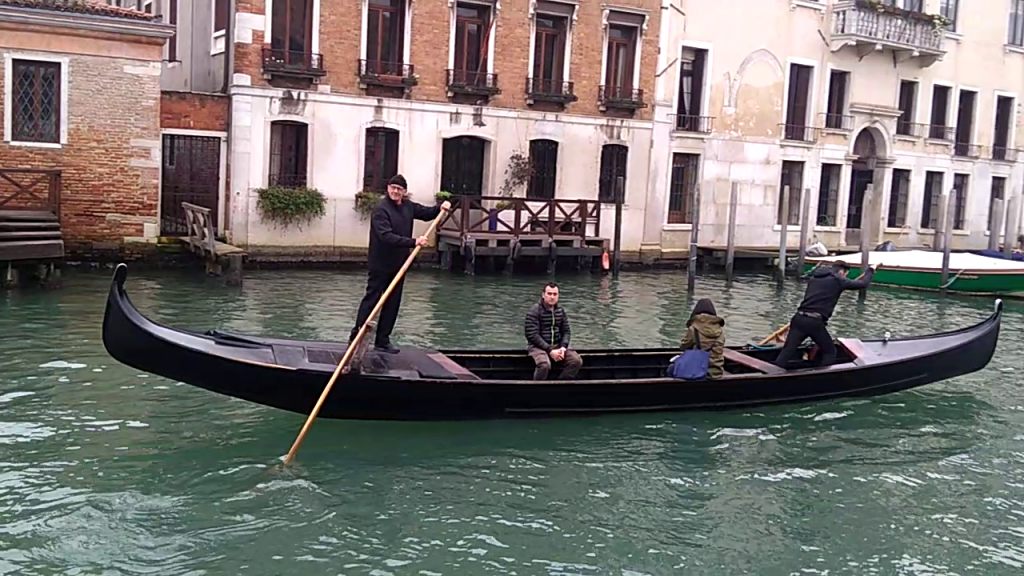
We are crossing the most frequented Gondola-crossing of the Grand Canal of Venice, San Tomà This type of service is called Traghetto and it’s just from one side to the other. The cost is 2 euro and it’s the cheapest Gondola ride you can find.
Vigili del fuoco – The Venetian fire brigade
In a city like Venice, Police and Firefighters have to go by boat. Every now and then you see them coming at full speed causing all the other watercrafts to stop and just try to stay afloat in the violent wakes. Look up Rio Cà Foscari, the wide canal to the right just when the Grand Canal of Venice turns left. There’s the fire brigade, and it’s from there, the big motorboats in red, part.
Cà Foscari

Cà Foscari is one of the biggest and most prestigious palaces on the Canal. It was built in mid-1400 for the Doge at the time, Francesco Foscari, by the architect Bartolomeo Bon (Who also completed Cà D’Oro). The style, as the case with Cà D’Oro is Gothic with the typical Byzantine features, and the Floral Gothic Venetian windows. It has two noble floors and the biggest private courtyard in Venice, after Palazzo Ducale at Saint Mark’s
Since 1868, two years after Venice’s annexation to the newborn nation, Italy, it is the home of the University of Venice. The institute started out as a Royal Highschool for commercial studies. It was actually the first higher education in that field in Italy. Today it is one of the top Universities in the country with a particular weight in faculties like Modern languages, Humanities, and of course Commerce, Economy, and Management.

Palazzo Grassi
Palazzo Grassi was the last big residential palace to be constructed on the Grand Canal of Venice before the fall of the Republic in 1797. It stood ready in 1772 and the late arrival makes it a bit different from the Gothic, Byzantine, and Baroque styles we’ve seen so far. It is a classic, formal middle-European style with a facade that lacks many of the typical Venetian attributes. Such as the mercantile opening on the ground floor towards the canal, and the noble floor with the Floral Venetian windows.
It is home to the Pinot Collection named after the French entrepreneur François Pinault. Together with the Modern Art Museum Punta della Dogana they offer exhibitions of contemporary art.

San Samuele
Next to Palazzo Grassi, at the Vaporetto stop, there’s a small Campo. At the far end, there’s the San Samuele church. It was built in the 11th century and then almost entirely rebuilt in 1685. Although small and hidden away from the mainstream tourist trails, it has some unique and very interesting features.
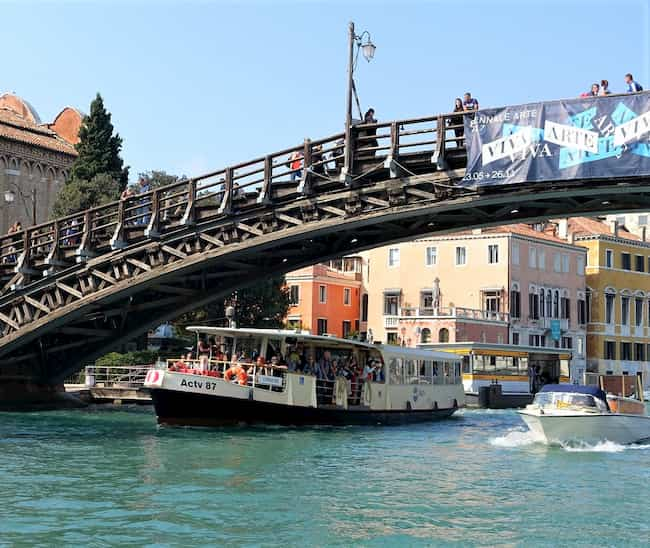
Ponte dell’Accademia, The Accademia Bridge. On the right-hand side lies maybe the finest Art Museum in Venice… Gallerie dell’Accademia. The bridge has its name from the Museum. The Bridge is a wooden bridge, and not the usual stone construction. The story is as follows:
In the mid-1800 it had become obvious that the one single bridge over the Grand Canal of Venice wasn’t enough. Rialto had become a true bottleneck as more people abandoned the boats and Gondolas for the more economical and practical simple walking. So the city decided to build two more bridges. One at the Railway station, and the other here at Accademia. Both bridges were made in a very short time by the British engineer and entrepreneur Alfred Henry Neville. And they were made in Iron. The construstìction in metal wasn’t ideal, though. And in just a few years the constructions started to show signs of decay.

After decades of problems and controversy, both bridges were replaced. At the railway station, they built the Ponte dei Scalzi, which we went under at the beginning of the trip. Here at Accademia, they built a provisional bridge in wood. In a little more than a month they completed the enterprise, and it was at the time the longest single-arc wooden bridge in Europe.
It was provisional, but the Venetians became so attached to their wooden Accademia bridge that any attempt to try to replace it, was punished severely by the Venetian voters. In 2018 it was completely overhauled. Most wooden parts were replaced and the steel frame was somewhat modernized with the use of new materials and high-tech solutions for the conservation of the metals. It was reopened on August 29, 2018.

Palazzo Cavalli Franchetti
On the left-hand side of the bridge, there is the Palazzo Cavalli Franchetti. It houses the Istituto Veneto di Scienze, Lettere ed Arti – Veneto institute for Science, Letters, and Arts. They hold frequent cultural events, as well as exhibitions.

Palazzi Barbaro
Right next to Palazzo Franchetti. Palazzo Barbaro Another Gothic Venetian palace. It is actually two palaces with their facades side by side. The left one was built by Giovanni Bon, the son of Bartolomeo (Cà D’Oro and Cà Foscari) in 1425. Many years later, in late 1600, the right one was added to the complex. The Baroque style contrasts quite a bit against the left palace, but somehow they seem to connect just the same.
In late 1800 the left building was bought by Daniel Sargent Curtis. He and his wife, Ariana, made the palace a sort of refuge and center for American intellectuals and artists in Venice. Henry James, Robert Browning, Claude Monet, Charles Eliot Norton are just a few names of people associated with the Curtis’ circle.
Palazzo Barbarigo
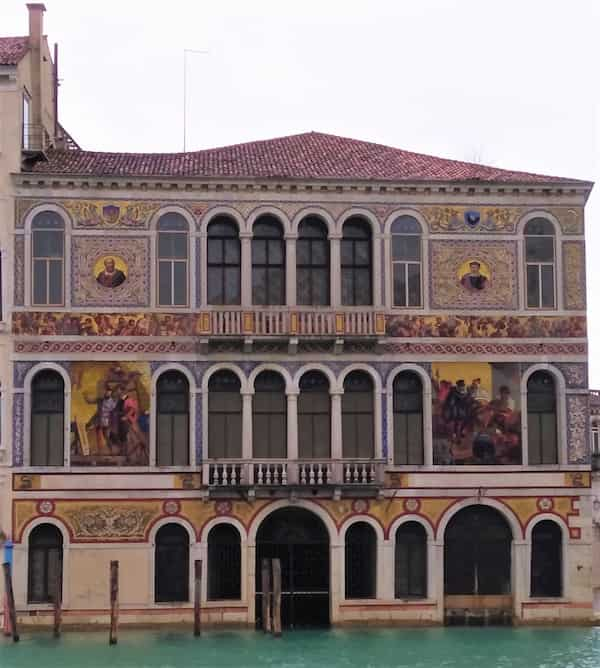
Between Palazzi Barbaro and the Guggenheim, there’s a marvelous but kind of strange palace on your right-hand side. It’s the Barbarigo Palace. There are otherpalaces with that same title in the city but they all have other names attached to the Barbarigo-label. This one is just Palazzo Barbarigo.
It’s not particular in any historical way and up until late 1800, it was just another mid-size renaissance palace on the canal. But then the Murano-Glass company Pauly & C. – Compagnia Venezia Murano decided to make it their headquarter. As a way of distinguishing the building for marketing purposes, they covered the whole facade with mosaics of Murano-glass.
The neighbors weren’t happy. They regarded the Testolini brothers, who owned the palace at the time, as nouveau riches. To them, the palace was right out ugly, and well suited for clowns like the Testolinis.
The truth is that most of the palaces during the renaissance were very colored and decorated. Ca d’Oro for example. Freschi, stucco, and gilt covered every angle of the Canal. Even the gondolas were in red, silver, and gold. Trends come and go.
Peggy Guggenheim Collection

Two palaces further ahead on the right, there’s a low, white building. That’s the Peggy Guggenheim Collection, Palazzo Venier dei Leoni. Although many people take it for a 1900-building, it is actually from the 1700s by the Venetian architect Lorenzo Boschetti. It was never finished and therefore it still has the low facade… Just one floor.
The Peggy Guggenheim Collection is very interesting. So is the life of the American Arts collector. She lived her last 30 years in Venice. And the collection is only 300 pieces, so you can enjoy it without ending up overwhelmed.
Fun fact: When they dredged the Grand Canal of Venice right in front of the palace, they found more than 2000 empty bottles of French Champagne. Peggy’s parties weren’t cheap and they weren’t sober..
Cà Dario
Cà Dario is the second palace after Guggenheim. And it’s the spookiest building in Venice.
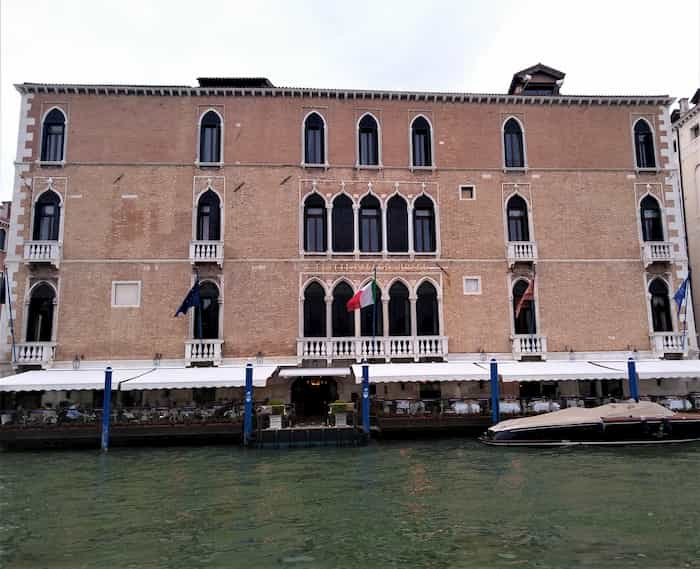
Gritti Palace
Just after the Vaporetto-stop, Gigli, there’s the nr.1 first class luxury hotel in Venice. The original palace was built in 1300, but it has been refurbished and modified many times. Until late 1800 it was only three floors.
Salute or Basilica di Santa Maria della Salute
The second last building on your right, is a big cathedral, Santa Maria della Salute. Salute as in Health. Because it was constructed to save the city from the Plague.
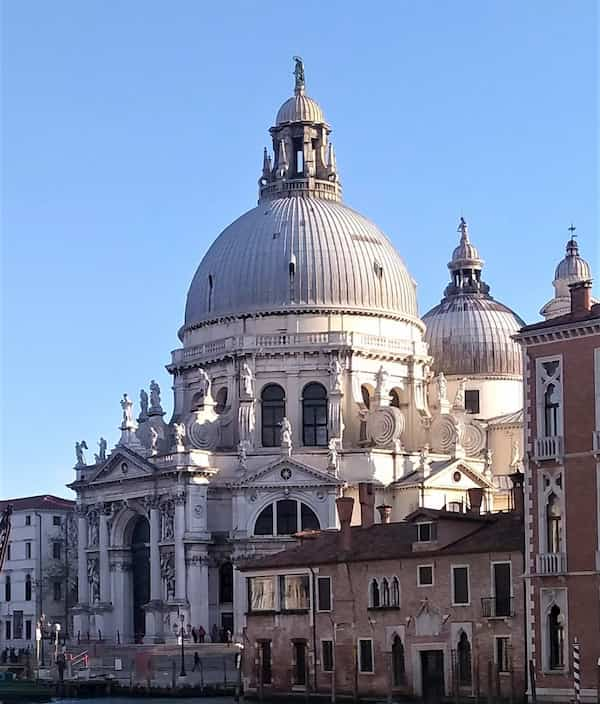
It was in 1630. An Ambassador from Mantova came to Venice to ask for assistance against the terrible plague. Mantova together with Milano, Bologna, Florens, and almost every other inland city was severely hit. So they came to ask the Venetians for assistance. But they brought the pestilence with them, and as the Venetians started dying, the only cure left was to pray to Virgin Mary, and to build her a cathedral.
In 1631 the work started. And with the construction came a solemn oath by the new Doge. Francesco Erizzo and the new Patriarch Federico Baldissera Bartolomeo Cornaro (The former Doge and Patriarch had both died from the Plague.). Every year on the last Sunday of November, a procession should take place to express thanks to the Virgin Mary for not having killed more than a third of the city’s population. The oath has been kept until modern time, and it’s one of a handful feasts that has remained unaltered through the ages. It is a very local Venetian Holiday for the Venetians.
The Church stood ready in 1687, and the architect was Baldassare Longhena
Punta della dogana
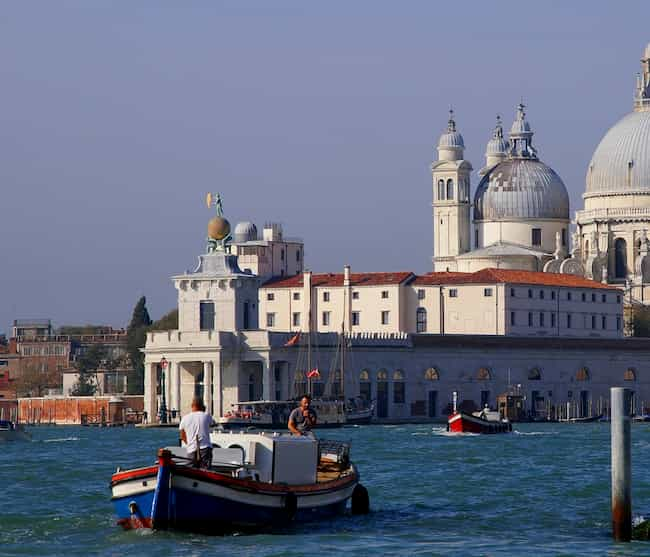
The last building on your right, before the canal of Venice is finished.
This was the customs house from 1682 until 1980. All merchandise ships had to register here before entering the city. On top of the building there’s a sculpture with two Atlases lifting a golden bronze sphere. And on the top of that, is Fortune, the goddess of prosperity and increase. She indicates the direction of the wind.
Punta della Dogana is also were the high tide is measured.
It is now an Contemporary Arts Museum in collaboration with Palazzo Grassi.
Royal Gardens
Depending on where you get off, right before Saint Mark’s Square there’s the Royal Garden. A strange and fantastic enterprise. Napoleon wanted a garden for his palace at the western end of the Square. So he knocked down a warehouse and build a Royal Garden. As Venice was ping-ponged between Austria, France, independance, and Italy, the gardens were never really cured, and they were never accessible… Until 2019. On December the 17th it reopened. And now you can stroll among exotic trees and plants, two steps from the crowds at Saint Mark’s, free of charge.
And why hasn’t it been destroyed by the frequent high waters? Because Napoleon was an ingenious little man. He raised the whole ground to save it from the rising sea levels. The Garden is a few steps up. And it’s over the high water levels It’s nothing less than a miracle… A French miracle but still a miracle…
San Marco
Saint Mark’s Square. We have arrived. The journey is at its end. Now, depending on were you want to continue, or if you are on nr.1 or nr.2, you can get off, or stay on board. And if you have a Venice City Pass abilitated for transport (Remember that even a single ticket is valid for 75 minutes, in both directions. So, it’s possible to go back again within that time-frame. As long as you don’t exceed 1 hour 15 min.), you can go back again and see more palaces on the Grand Canal of Venice.
The most beautiful City Main Street in the world.
